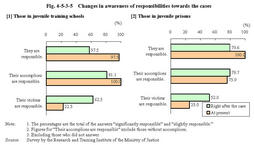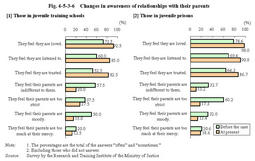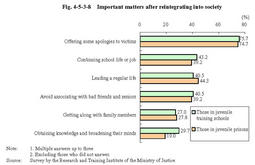| Previous Next Index Image Index Year Selection | |
|
|
3 Awareness of responsibilities towards cases Fig.4-5-3-5 shows the changes in their awareness of responsibilities towards the cases.
As for those in juvenile training schools,the percentage of those considering their accomplices as responsible(the total of the answers"significantly responsible"and"slightly responsible";hereinafter the same)were highest right after the case,followed by those considering their victims as responsible.The percentage of those considering themselves as responsible was the lowest.However,at present when they are accommodated in juvenile training schools,the percentage of those considering them and their accomplices as responsible increased,while that of those considering their victims as responsible decreased sharply.Through guidance on friendship implemented at juvenile training schools,they seem to have deepened their understanding of their accomplices'responsibilities and their own responsibilities. As for those in juvenile prisons,the percentage was high for those considering them and their accomplices as equally responsible from right after the case.At present when they are accommodated in prisons,the percentage of those considering they are responsible rose,while that for those considering their accomplices as responsible decreased slightly.The percentage of those considering their victims as responsible showed a sharp decline,as in the case with those in juvenile training schools. Fig.4-5-3-5 Changes in awareness of responsibilities towards the cases Fig.4-5-3-6 shows the changes in their awareness of relationships with their parents.Comparing their awareness before the case and at present,those in juvenile training schools and those in prisons both showed an increase in friendly emotions towards their parents and a decrease in negative emotions towards their parents. Fig.4-5-3-6 Changes in awareness of relationships with their parents Fig.4-5-3-7 shows the changes in what they consider as brakes in their mind that discourage them from committing offenses.As for both those in juvenile training schools and those in prisons,the percentage of"being arrested by the police"and"having no brakes in mind"decreased sharply but that of"family matters"increased significantly at present,compared to answers before the case.This may be because they have developed friendly emotions towards their families and have come to consider them as what they can believe in. Fig.4-5-3-7 Changes in what they consider as brakes in their mind Fig.4-5-3-8 shows the awareness of important matters after reintegrating into society.As for both those in juvenile training schools and those in prisons,the percentage was highest for those who are aware of the importance of"offering some apologies to victims."Furthermore,answers to lead a sound life and not to associate with bad company showed high percentages,such as"Continuing school life or job,""Leading a regular life,"and"Avoid associating with bad company and seniors." Fig.4-5-3-8 Important matters after reintegrating into society Fig.4-5-3-9 shows the awareness of worries after reintegrating into society.As for both those in juvenile training schools and those in prisons,the percentage was high for those who worry about how to offer apologies for victims,which they consider very important after reintegrating into society.Those in juvenile training schools seem to have more anxieties about life after discharge,showing a higher percentage in those who worry about various matters than those in prisons. Fig.4-5-3-9 Worries after reintegrating into society |




